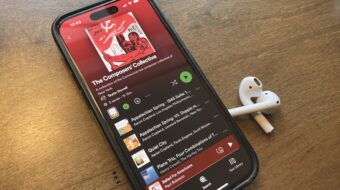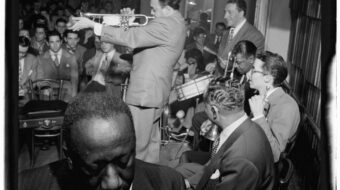Music has always been a powerful tool in organizing social justice movements, expressing political consciousness and raising cultural awareness.
Hip-hop, born in the USA, is a worldwide cultural phenomenon that originated in African American, Latino and other urban working-class communities to communicate life experiences through poetic lyrics over rhythmic beats. Like folk tunes, the blues and jazz, an important aspect of hip-hop is its message of social, political and economic justice.
On Nov. 29, over 400 students from 16 public high schools came together at the “Chicago Hip Hop and Youth Empowerment Summit” to promote unity and social justice in an evening of speak-out sessions, panel discussions, performances, art, information distribution and speeches. The summit took place at DePaul University on the city’s north side.
“Hip-hop is not just the music,” said DePaul student Moises Arteaga. “It’s the vibe, the culture, the art, the break-dancing, spoken word and poetry. I strongly believe that hip-hop today is letting younger people express their thoughts, their message and it’s all in the lyrics.”
Arteaga said he was first introduced to hip-hop at age nine when he heard 2Pac’s “Thugs Mansion” track.
“Most people think hip-hop is just negative,” Arteaga said. “But if you listen there are messages to educate about real life experiences that others have gone through.”
At the summit over a dozen youth-led citywide groups addressed issues about education, community violence, drug addiction, domestic abuse, student dropout rates, the criminalization of young people, and hip-hop in the media. The image of women and the use of derogatory words in hip-hop were also discussed.
Jaquanda Villegas and Jacinda Bullie, with Kuumba Lynx, a community-based youth empowerment and hip-hop entertainment group, were there.
“Hip-hop to me is connecting to our roots, our inner-voice,” said Villegas. “If it’s used properly, it’s a tool to educate and entertain.”
Bullie said hip-hop “has the potential to mobilize our communities, and oral traditions have always been a part of changing history.” She said her favorite artist is Roxanne Shante because in a contract she signed when she was very young, she agreed to record music only if the label would pay for her education.
Amaru Kabba, 13, said since he has been break-dancing his grades at school have improved. “Through hip-hop I can express myself,” he said. “I want to be the greatest b-boy!”
High school senior Oswaldo Gamez called graffiti an artistic and therapeutic form of expression. “There is no racism in graffiti and you can easily make friends,” he said.
The four elements
Many would agree that DJ-ing, emceeing, break-dancing and graffiti art comprise the four most important elements of hip-hop culture.
Hip-hop dates back to the 1970s, when DJs began isolating the percussion break from funk or disco songs. The emcee would introduce the DJ and music, keeping the audience excited by speaking between songs. Eventually the emcee’s role became more stylized and evolved into rapping.
As block parties accompanied by funk and soul music became common in New York City, especially in the Bronx, the earliest forms of hip-hop arose with the DJ tradition of mixing hit songs, scratching techniques and danceable beats. Looping, sampling and remixing original music would become a hallmark of the hip-hop style.
In break-dancing, b-boys and b-girls battled each other before block party audiences with their best moves. Creating hip-hop music was inexpensive and virtually anyone could emcee along with the popular beats of the day. The skills to create rap songs were passed informally from musician to musician.
As disco, funk and rock declined, hip-hop became more popular. By 1979, hip-hop had become a commercially recorded genre, and began to enter the American mainstream. Though women, whites and Latinos had long been a part of the scene, it was not until the 1980s that groups other than young African American males began creating popular, innovative and distinctive music styles.
The first female solo hip-hop artist to record was Philadelphia-based Lady B with “To the Beat Y’All” in 1980. Salt-N-Pepa became the first Black female group to hit the charts with singles like “The Show Stoppa” in 1985.
International phenomenon
In the 1990s, hip-hop began to reach mainstream audiences in Europe, Africa and Asia. Hip-hop stars rose to prominence in South Africa, Germany, France, Italy and elsewhere, incorporating musical influences from their own countries. In South Africa, Black Noise created tracks against the apartheid-era government, while in Europe hip-hop was the domain of both native ethnic nationalities and immigrants.
Although rap music began to reach all corners of the U.S., New York City remained the capital of hip-hop in the 1980s and many see it as the Mecca of hip-hop today. Artists such as Kurtis Blow, LL Cool J and Run-D.M.C. were among the first popular hip-hop emcees.
“Gangsta rap” originated on the west coast with Ice-T’s “6N’ Da Morning” track. The first mainstream gangsta rap album, selling more than 2.5 million copies, was N.W.A.’s “Straight Outta Compton” (1988), including controversial subjects like drugs, violence and sex.
A love for hip-hop
Summit organizer Billie Drakeford, 24, said its goal was to provide a space for youth to expose hip-hop culture in the context of the issues they face in society. She added that building citywide youth and community unity through talent was also a main feature.
Whether from the Bronx, the south side of Chicago or Los Angeles, hip-hop has always been an alternative and an outlet for working-class youth with talent and skill, said Justin Grey, 25, program coordinator with the community-based youth and family agency Alternatives.
“Being fresh, mad dressed, with dope skills and being able to rock the microphone” are all part of the culture, Grey said. “It’s just something that we love. But the media only exposes negative aspects of hip-hop that ultimately perpetuate violence, and uses these aspects as an excuse to shoot it down.”
“Hip-hop has spread all over the world,” said Grey. “It’s how you live and it’s a way of life,” he said.












Comments